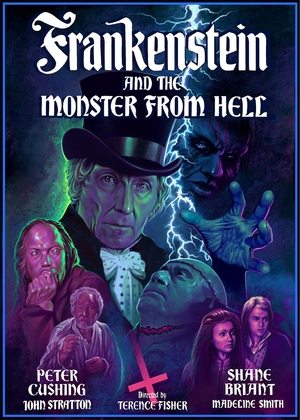
Frankenstein and the Monster from Hell
Neolithic Lobotomy Gone Astray. Frankenstein and the Monster from Hell is directed by Terence Fisher and written by John Elder (AKA: Anthony Hinds). It stars Peter Cushing, David Prowse, Shane Briant, Madeline Smith and John Stratton. Music is by James Bernard and cinematography by Brian Probyn. Working under the name of Doctor Victor, Baron Victor Frankenstein (Cushing) is head physician at an asylum for the criminally insane. When Simon Helder (Briant), a gifted doctor himself and a follower of Frankenstein’s work, is committed to the asylum on sentence of sorcery, the pair quickly form a partnership that will unleash Frankenstein’s latest project… Actually made in 1972 but released two years later, Frankenstein and the Monster from Hell came out as Hammer Horror was limping along on its last legs. It was to be the last in the Frankenstein series and the last film directed by the brilliant Fisher. The reputation of the film is a very mixed one, certainly the box office returns and critical notices at the time point it out as a misfire. But what I have come to find is that staunch Hammer Horror fans have a kind regard towards the film, and I think that is fair given that it pretty much goes back to past glories, if not in scope, but in narrative and atmospheric toning. Yes it is viable to say that it’s pretty much a rejig of the earlier Revenge of Frankenstein, so in that it’s a bit lazy, but I like to think that the return of Cushing, Fisher and Hinds suggests they were making one for the fans here, and it’s not without merits in spite of familiarity and budgetary restrictions. It’s great to have Cushing back as Victor, his personal life woes giving him a gaunt look that suits Frankenstein’s character arc no end, this in spite of the daft wig he dons and a moment of Superman type heroics that doesn’t quite sit right. Briant is ebullient and good foil in the mixed up surgeon stakes, and Smith adds the Hammer Glamour without having to strip naked. Why? Why? Why? But it’s with the setting, the asylum and its characters, and the monster itself where it hits heights not acknowledged by the critics. Prowse’s monster is a return to tragicreature territory, with the brain of a genius who wanted out of life, the hands of a skilled craftsman and a Neolithic monstrosity of a body, once the creature knows what he has become his sadness pours out in droves. Prowse doing a great job of conveying such tragedy with visual reactions and bodily movements. The mask unfortunately means when it speaks the lips don’t move, but it’s a fine Hammer creation regardless. The asylum inmates are in terms quirky and troubling, and with most of the shoot restricted to a couple of interior sets, the sense of being incarcerated is evident. Props are minimal, with a few of the good doctors odd looking tools and machines dotted around the place. The gore is used sparingly, but the impact is in the grand traditions of Hammer, while the back stories to Smith’s mute and Asylum Director Adolf Klauss (Stratton) are edgy strands waiting to be pulled at in the name of Guignol entertainment. It’s not a great send off for Doc Frank in Hammer world, not least because the finale lacks punch, but for loyal fans of the studio’s creature features there is love and honest respect shown by the makers. 6.5/10
